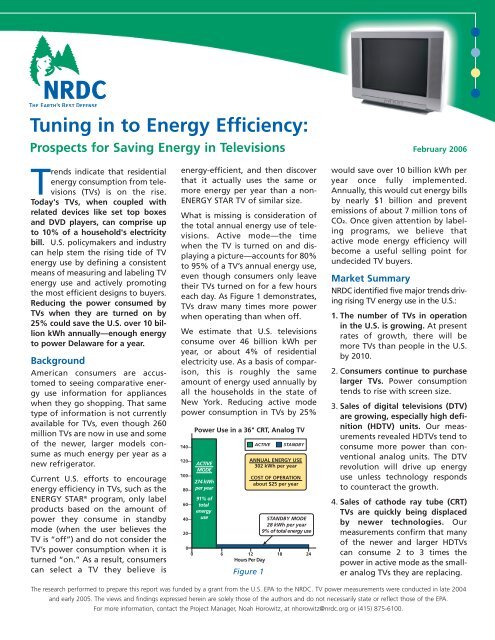NRDC: Prospects for Saving Energy in Televisions (pdf)
NRDC: Prospects for Saving Energy in Televisions (pdf)
NRDC: Prospects for Saving Energy in Televisions (pdf)
Create successful ePaper yourself
Turn your PDF publications into a flip-book with our unique Google optimized e-Paper software.
Tun<strong>in</strong>g <strong>in</strong> to <strong>Energy</strong> Efficiency:<br />
<strong>Prospects</strong> <strong>for</strong> <strong>Sav<strong>in</strong>g</strong> <strong>Energy</strong> <strong>in</strong> <strong>Televisions</strong> February 2006<br />
Trends <strong>in</strong>dicate that residential<br />
energy consumption from televisions<br />
(TVs) is on the rise.<br />
Today's TVs, when coupled with<br />
related devices like set top boxes<br />
and DVD players, can comprise up<br />
to 10% of a household's electricity<br />
bill. U.S. policymakers and <strong>in</strong>dustry<br />
can help stem the ris<strong>in</strong>g tide of TV<br />
energy use by def<strong>in</strong><strong>in</strong>g a consistent<br />
means of measur<strong>in</strong>g and label<strong>in</strong>g TV<br />
energy use and actively promot<strong>in</strong>g<br />
the most efficient designs to buyers.<br />
Reduc<strong>in</strong>g the power consumed by<br />
TVs when they are turned on by<br />
25% could save the U.S. over 10 billion<br />
kWh annually—enough energy<br />
to power Delaware <strong>for</strong> a year.<br />
Background<br />
American consumers are accustomed<br />
to see<strong>in</strong>g comparative energy<br />
use <strong>in</strong><strong>for</strong>mation <strong>for</strong> appliances<br />
when they go shopp<strong>in</strong>g. That same<br />
type of <strong>in</strong><strong>for</strong>mation is not currently<br />
available <strong>for</strong> TVs, even though 260<br />
million TVs are now <strong>in</strong> use and some<br />
of the newer, larger models consume<br />
as much energy per year as a<br />
new refrigerator.<br />
Current U.S. ef<strong>for</strong>ts to encourage<br />
energy efficiency <strong>in</strong> TVs, such as the<br />
ENERGY STAR ® program, only label<br />
products based on the amount of<br />
power they consume <strong>in</strong> standby<br />
mode (when the user believes the<br />
TV is “off”) and do not consider the<br />
TV’s power consumption when it is<br />
turned “on.” As a result, consumers<br />
can select a TV they believe is<br />
energy-efficient, and then discover<br />
that it actually uses the same or<br />
more energy per year than a non-<br />
ENERGY STAR TV of similar size.<br />
What is miss<strong>in</strong>g is consideration of<br />
the total annual energy use of televisions.<br />
Active mode—the time<br />
when the TV is turned on and display<strong>in</strong>g<br />
a picture—accounts <strong>for</strong> 80%<br />
to 95% of a TV’s annual energy use,<br />
even though consumers only leave<br />
their TVs turned on <strong>for</strong> a few hours<br />
each day. As Figure 1 demonstrates,<br />
TVs draw many times more power<br />
when operat<strong>in</strong>g than when off.<br />
We estimate that U.S. televisions<br />
consume over 46 billion kWh per<br />
year, or about 4% of residential<br />
electricity use. As a basis of comparison,<br />
this is roughly the same<br />
amount of energy used annually by<br />
all the households <strong>in</strong> the state of<br />
New York. Reduc<strong>in</strong>g active mode<br />
power consumption <strong>in</strong> TVs by 25%<br />
Figure 1<br />
would save over 10 billion kWh per<br />
year once fully implemented.<br />
Annually, this would cut energy bills<br />
by nearly $1 billion and prevent<br />
emissions of about 7 million tons of<br />
CO2. Once given attention by label<strong>in</strong>g<br />
programs, we believe that<br />
active mode energy efficiency will<br />
become a useful sell<strong>in</strong>g po<strong>in</strong>t <strong>for</strong><br />
undecided TV buyers.<br />
Market Summary<br />
<strong>NRDC</strong> identified five major trends driv<strong>in</strong>g<br />
ris<strong>in</strong>g TV energy use <strong>in</strong> the U.S.:<br />
1. The number of TVs <strong>in</strong> operation<br />
<strong>in</strong> the U.S. is grow<strong>in</strong>g. At present<br />
rates of growth, there will be<br />
more TVs than people <strong>in</strong> the U.S.<br />
by 2010.<br />
2. Consumers cont<strong>in</strong>ue to purchase<br />
larger TVs. Power consumption<br />
tends to rise with screen size.<br />
3. Sales of digital televisions (DTV)<br />
are grow<strong>in</strong>g, especially high def<strong>in</strong>ition<br />
(HDTV) units. Our measurements<br />
revealed HDTVs tend to<br />
consume more power than conventional<br />
analog units. The DTV<br />
revolution will drive up energy<br />
use unless technology responds<br />
to counteract the growth.<br />
4. Sales of cathode ray tube (CRT)<br />
TVs are quickly be<strong>in</strong>g displaced<br />
by newer technologies. Our<br />
measurements confirm that many<br />
of the newer and larger HDTVs<br />
can consume 2 to 3 times the<br />
power <strong>in</strong> active mode as the smaller<br />
analog TVs they are replac<strong>in</strong>g.<br />
The research per<strong>for</strong>med to prepare this report was funded by a grant from the U.S. EPA to the <strong>NRDC</strong>. TV power measurements were conducted <strong>in</strong> late 2004<br />
and early 2005. The views and f<strong>in</strong>d<strong>in</strong>gs expressed here<strong>in</strong> are solely those of the authors and do not necessarily state or reflect those of the EPA.<br />
For more <strong>in</strong><strong>for</strong>mation, contact the Project Manager, Noah Horowitz, at nhorowitz@nrdc.org or (415) 875-6100.
Household <strong>Energy</strong> Use <strong>for</strong> Enterta<strong>in</strong>ment Electronics<br />
Large-screen HDTV<br />
DVD/VCR<br />
HD Set top box<br />
Small-screen analog TV<br />
DVD/VCR<br />
Digital cable<br />
set top box<br />
Comb<strong>in</strong>ed energy use<br />
–1200 kWh per year<br />
Figure 2<br />
Primary TV<br />
Secondary TV<br />
200 400 600<br />
Annual <strong>Energy</strong> Use (kWh)<br />
5. Americans are watch<strong>in</strong>g more<br />
hours of TV per day from more<br />
sources, mak<strong>in</strong>g the active mode<br />
component of a TV’s overall energy<br />
consumption even more<br />
important, mostly due to the<br />
advent of cable/satellite services,<br />
home video (VCRs and DVDs),<br />
and video games. These additional<br />
services usually require extra<br />
power-consum<strong>in</strong>g audiovisual<br />
equipment such as set top boxes<br />
and video game consoles. Figure<br />
2 underscores the importance of<br />
the overall category of “enterta<strong>in</strong>ment<br />
electronics” by show<strong>in</strong>g<br />
the energy a household might<br />
consume to power these devices<br />
<strong>in</strong> the future. The TV and associated<br />
electronics amount to 1200<br />
kWh per year—over 10% of the<br />
average household’s annual electricity<br />
bill.<br />
These trends together suggest that<br />
no policy measures are likely to<br />
reduce nationwide TV energy consumption<br />
<strong>in</strong> the near future.<br />
However, it may be possible to trim<br />
expected growth <strong>in</strong> that energy consumption<br />
by def<strong>in</strong><strong>in</strong>g consistent<br />
means of measur<strong>in</strong>g and label<strong>in</strong>g TV<br />
energy use and actively promot<strong>in</strong>g<br />
the most efficient designs to buyers.<br />
Test Methods<br />
A handful of test methods have<br />
been developed to measure active<br />
mode power <strong>in</strong> TVs. The United<br />
States Department of <strong>Energy</strong> (DOE)<br />
national standard <strong>for</strong> TV power<br />
measurement dates back to the<br />
year 1977 and is only meant to be<br />
used on black-and-white CRTs. The<br />
procedure is so outdated that no<br />
manufacturers use it <strong>in</strong> their report<strong>in</strong>g<br />
of power consumption to UL.<br />
The International Electrotechnical<br />
Commission (IEC) ma<strong>in</strong>ta<strong>in</strong>s a<br />
standard <strong>for</strong> measur<strong>in</strong>g power <strong>in</strong><br />
audiovisual electronics—IEC 62087.<br />
This method measures the active<br />
mode power use of current screen<br />
technologies (LCD, plasma, etc.) <strong>in</strong> a<br />
fair way by us<strong>in</strong>g an <strong>in</strong>dustryapproved<br />
video test pattern to calibrate<br />
a TV’s brightness sett<strong>in</strong>gs.<br />
Mandatory and voluntary label<strong>in</strong>g<br />
programs <strong>in</strong> Europe, Australia,<br />
Japan and Ch<strong>in</strong>a have adopted and<br />
written national standards <strong>in</strong> harmony<br />
with IEC 62087.<br />
However, technical experts still feel<br />
that there is room <strong>for</strong> improvement<br />
<strong>in</strong> IEC 62087. The specified screen<br />
calibration levels are known to be<br />
lower than typical user sett<strong>in</strong>gs and<br />
significantly below factory sett<strong>in</strong>gs,<br />
underestimat<strong>in</strong>g actual energy use<br />
<strong>in</strong> a home sett<strong>in</strong>g. Such estimates<br />
are absolutely essential <strong>in</strong> provid<strong>in</strong>g<br />
consumers with <strong>in</strong><strong>for</strong>mation to<br />
compare their expected annual<br />
energy use and operat<strong>in</strong>g costs.<br />
Recent TV Measurements<br />
Our research was necessarily limited<br />
<strong>in</strong> scope and budget, so we<br />
attempted to scout the range of<br />
expected energy use <strong>in</strong> televisions<br />
of various sizes, resolutions and<br />
technology types. Rather than fol-<br />
low<strong>in</strong>g IEC 62087 setup and measurement<br />
procedures <strong>for</strong> a handful<br />
of models <strong>in</strong> the laboratory, we<br />
measured the average active mode<br />
power use of a larger number of<br />
retail models us<strong>in</strong>g audio and visual<br />
<strong>in</strong>puts that were available on site.<br />
The screen sett<strong>in</strong>gs were left at<br />
their factory defaults. Our data are<br />
generally <strong>in</strong>dicative of real world<br />
TV power consumption, but still<br />
subject to some uncerta<strong>in</strong>ty relative<br />
to more costly and time-consum<strong>in</strong>g<br />
laboratory measurements.<br />
Three key factors <strong>in</strong>fluence the<br />
amount of power TVs consume <strong>in</strong><br />
operation. Listed <strong>in</strong> descend<strong>in</strong>g<br />
order of importance, they are:<br />
screen area, display technology and<br />
resolution level.<br />
Display technology is the ma<strong>in</strong> factor<br />
manufacturers can control to<br />
<strong>in</strong>crease the energy efficiency of<br />
TVs with a given set of features.<br />
Figure 3 shows a wide array of<br />
HDTVs of different sizes and display<br />
technologies and the amount of<br />
power that they consume when<br />
operat<strong>in</strong>g. Several conclusions can<br />
be drawn from the figure:<br />
• In direct view TVs, the larger the<br />
screen, the more power the TV<br />
consumes. Projection TVs, on the<br />
other hand, consume roughly the<br />
same amount of power regardless<br />
of size. In larger TV sizes<br />
(above 40 <strong>in</strong>ches), projection TVs<br />
consume far less power than similarly<br />
sized direct view TVs.<br />
• Plasma TVs consume more power<br />
than rear projection TVs of similar<br />
or greater size. More measurements<br />
are needed to determ<strong>in</strong>e<br />
how plasma displays compare to<br />
similarly sized LCD flat panel displays,<br />
but anecdotal data reported<br />
by third parties suggests that
500<br />
400<br />
300<br />
200<br />
100<br />
0<br />
they follow a similar power consumption<br />
trend <strong>in</strong> these larger<br />
sizes. Major plasma TV manufacturers<br />
are currently <strong>in</strong>troduc<strong>in</strong>g<br />
more efficient models <strong>in</strong>to the<br />
market.<br />
• There is great variation <strong>in</strong> power<br />
consumption even with<strong>in</strong> TVs of<br />
the same size and screen display<br />
technologies.<br />
<strong>Energy</strong> Use and<br />
<strong>Sav<strong>in</strong>g</strong>s Estimates<br />
We estimate that the U.S. uses over<br />
46 billion kWh every year to power<br />
TVs, which represents over 1% of all<br />
U.S. electricity use. It means consumers<br />
are spend<strong>in</strong>g more than $13<br />
billion each year to buy new TVs,<br />
and almost $4 billion each year to<br />
operate the ones they have.<br />
Our research shows that the U.S.<br />
could save billions of kWh of electricity<br />
<strong>in</strong> the near future if a nationwide<br />
voluntary label<strong>in</strong>g program<br />
like ENERGY STAR adopted a 25%<br />
reduction <strong>in</strong> active mode power<br />
from measured average values <strong>in</strong> a<br />
future TV specification. Figure 4<br />
shows how the expected growth of<br />
Active Mode Power <strong>in</strong> DTVs<br />
0 500 1000 1500 2000<br />
Screen Area (square <strong>in</strong>ches)<br />
Figure 3<br />
CRT-Direct View<br />
CRT-Projection<br />
LCD-Direct View<br />
LCD-Projection<br />
Plasma-Direct View<br />
DLP-Projection<br />
LCOS-Projection<br />
TV energy use could be trimmed<br />
depend<strong>in</strong>g on the share of new TV<br />
sales that comply with such energy<br />
efficiency guidel<strong>in</strong>es. Because of the<br />
rise <strong>in</strong> DTV products and the ever<strong>in</strong>creas<strong>in</strong>g<br />
number of TVs <strong>in</strong> operation<br />
<strong>in</strong> the U.S., these active mode<br />
sav<strong>in</strong>gs become <strong>in</strong>creas<strong>in</strong>gly important<br />
<strong>in</strong> the future. Once fully implemented,<br />
the U.S. could save over 10<br />
billion kWh and $800 million <strong>in</strong><br />
energy bills per year through such<br />
efficiency targets.<br />
Annual <strong>Energy</strong> Consumption (billions kWh)<br />
80<br />
75<br />
70<br />
65<br />
60<br />
Policy Review<br />
Programs address<strong>in</strong>g standby mode<br />
energy use have been around <strong>for</strong><br />
several years, but a number of <strong>in</strong>ternational<br />
programs address<strong>in</strong>g<br />
active mode power use will soon<br />
raise the bar <strong>for</strong> TV energy efficiency.<br />
These programs use the IEC<br />
62087 test procedure to measure<br />
active mode power consumption <strong>in</strong><br />
TVs. Most also use a per<strong>for</strong>mance<br />
metric known as the energy efficiency<br />
<strong>in</strong>dex (EEI) to rank TVs by various<br />
functional attributes. In addition,<br />
some nations have m<strong>in</strong>imum<br />
energy per<strong>for</strong>mance standards<br />
(MEPS) <strong>for</strong> TVs that set mandatory<br />
m<strong>in</strong>imum efficiency levels <strong>for</strong> TVs.<br />
Australia will even beg<strong>in</strong> mandatory<br />
energy efficiency label<strong>in</strong>g <strong>for</strong> TVs<br />
through its <strong>Energy</strong> Rat<strong>in</strong>g program,<br />
currently used to provide energy<br />
efficiency <strong>in</strong><strong>for</strong>mation to consumers<br />
<strong>for</strong> other high-power appliances<br />
like refrigerators and furnaces.<br />
U.S. consumers are generally<br />
unaware of the energy efficiency of<br />
their TVs because they lack <strong>in</strong><strong>for</strong>mation<br />
about the total annual energy<br />
consumption of the product. The<br />
Estimated U.S. Annual <strong>Energy</strong> Consumption by TVs<br />
Base Case<br />
Improved case: 25% sales of efficient models<br />
Improved case: 50% sales of efficient models<br />
Improved case: 75% sales of efficient models<br />
55<br />
2005 2006 2007 2008 2009<br />
Figure 4
ENERGY STAR voluntary label<strong>in</strong>g<br />
program is currently the only U.S.<br />
program that promotes energy efficiency<br />
<strong>in</strong> TVs. ENERGY STAR’s standby<br />
mode limits range from 1 to 15<br />
watts depend<strong>in</strong>g on the technology<br />
type, with most requirements dropp<strong>in</strong>g<br />
to 1 watt or less on July 1, 2005.<br />
The ENERGY STAR Web site provides<br />
a list of qualify<strong>in</strong>g products, but<br />
does not disclose the range of measured<br />
standby mode power levels,<br />
active mode power levels or estimated<br />
total annual energy use <strong>for</strong><br />
each model. Even magaz<strong>in</strong>es, like<br />
Consumer Reports, and most manufacturers<br />
do not report active mode<br />
power use or estimated annual electricity<br />
use <strong>for</strong> televisions.<br />
As a result, we have a market <strong>in</strong><br />
which consumers can purchase TVs<br />
us<strong>in</strong>g 500 or even 1,000 kWh per<br />
year—far more than a new refrigerator,<br />
dishwasher, or clothes washer—without<br />
ever know<strong>in</strong>g the<br />
impact such a purchase will have on<br />
their electricity bills. This is a recipe<br />
<strong>for</strong> ever-<strong>in</strong>creas<strong>in</strong>g television energy<br />
use, because consumers and electric<br />
utilities can only take action to<br />
improve television energy efficiency<br />
if they first know how energy-efficient<br />
televisions are.<br />
Recommendations<br />
<strong>NRDC</strong> recommends three important<br />
actions to help the U.S. improve the<br />
active mode energy efficiency of<br />
TVs without sacrific<strong>in</strong>g quality or<br />
per<strong>for</strong>mance, and to provide consumers<br />
with the <strong>in</strong><strong>for</strong>mation they<br />
need to make energy-efficient buy<strong>in</strong>g<br />
decisions:<br />
Technical preparations—It is essential<br />
to the success of future TV<br />
energy efficiency measures that the<br />
DOE replace its antiquated TV test<br />
procedure and adopt a national TV<br />
test standard based on IEC 62087.<br />
We recommend that the U.S. take a<br />
lead<strong>in</strong>g role <strong>in</strong> revis<strong>in</strong>g IEC 62087’s<br />
screen calibration sett<strong>in</strong>gs to more<br />
accurately reflect real world use and<br />
energy consumption. Analysts and<br />
policymakers also need to come to<br />
consensus on TV operation patterns.<br />
The energy efficiency community<br />
and <strong>in</strong>dustry need to agree upon a<br />
metric <strong>for</strong> compar<strong>in</strong>g television<br />
energy consumption. We recommend<br />
that TVs of similar size and<br />
picture resolution (SD, ED, HD, etc.)<br />
be compared to each other us<strong>in</strong>g<br />
their estimated annual energy consumption<br />
<strong>in</strong> kWh. This metric<br />
relates directly to a consumer’s<br />
energy bill and would easily ga<strong>in</strong><br />
acceptance because energy efficiency<br />
label<strong>in</strong>g is already standard practice<br />
<strong>for</strong> large appliances.<br />
Mandatory label<strong>in</strong>g—The U.S.<br />
Department of <strong>Energy</strong> (DOE) and<br />
the Federal Trade Commission (FTC)<br />
should take advantage of their exist<strong>in</strong>g<br />
authority to extend <strong>Energy</strong>Guide<br />
label<strong>in</strong>g beyond traditional appliances<br />
to televisions and other major<br />
consumer electronics products.<br />
As illustrated <strong>in</strong> Figure 5, the new<br />
<strong>Energy</strong>Guide label <strong>for</strong> TVs should<br />
provide <strong>in</strong><strong>for</strong>mation on:<br />
This Model Uses<br />
350 kWh/yr.<br />
<strong>Energy</strong> Use (kWh/year) range of all similar models<br />
Uses Least<br />
<strong>Energy</strong><br />
277<br />
Figure 5<br />
Uses Most<br />
<strong>Energy</strong><br />
426<br />
• the amount of energy used to<br />
operate the TV annually, based<br />
on a standard duty cycle<br />
• the cost to operate the TV annually,<br />
based on energy use and typical<br />
electricity prices<br />
• the range of annual energy consumption<br />
<strong>for</strong> other TVs of comparable<br />
size and resolution.<br />
Voluntary label<strong>in</strong>g—We recommend<br />
that the ENERGY STAR program<br />
revise its TV specification to<br />
<strong>in</strong>clude active mode efficiency.<br />
The new specification should evaluate<br />
TV energy efficiency based<br />
on the amount of functional per<strong>for</strong>mance<br />
provided (screen area<br />
and picture resolution) per kWh<br />
of total annual electricity use. The<br />
annual energy consumption of a<br />
TV would be determ<strong>in</strong>ed the same<br />
way DOE would determ<strong>in</strong>e it <strong>for</strong><br />
mandatory label<strong>in</strong>g—by measur<strong>in</strong>g<br />
average standby and active<br />
mode power consumption and<br />
multiply<strong>in</strong>g by typical hours of<br />
operation <strong>in</strong> each mode.<br />
The specification should grant<br />
allowances <strong>for</strong> additional electronic<br />
functions like CableCARDs that<br />
result <strong>in</strong> fixed <strong>in</strong>creases <strong>in</strong> energy<br />
consumption. Hav<strong>in</strong>g separate specifications<br />
<strong>for</strong> different screen technologies<br />
like CRTs, LCDs, plasma,<br />
DLP, etc. is not recommended, as<br />
consumers should be encouraged to<br />
buy the most efficient TV not just<br />
the most efficient TV of a given<br />
technology type. Specification<br />
curves drawn on a graph of annual<br />
energy use vs. screen area could<br />
account <strong>for</strong> different levels of resolution,<br />
features and per<strong>for</strong>mance.<br />
Project managed by Noah Horowitz, <strong>NRDC</strong> Senior Scientist. Prepared by Peter Ostendorp of Ecos Consult<strong>in</strong>g. This document presents the<br />
abridged f<strong>in</strong>d<strong>in</strong>gs of a larger <strong>NRDC</strong> report on TV energy efficiency, available at http://www.nrdc.org/air/energy/energyeff/tv.<strong>pdf</strong>.
















